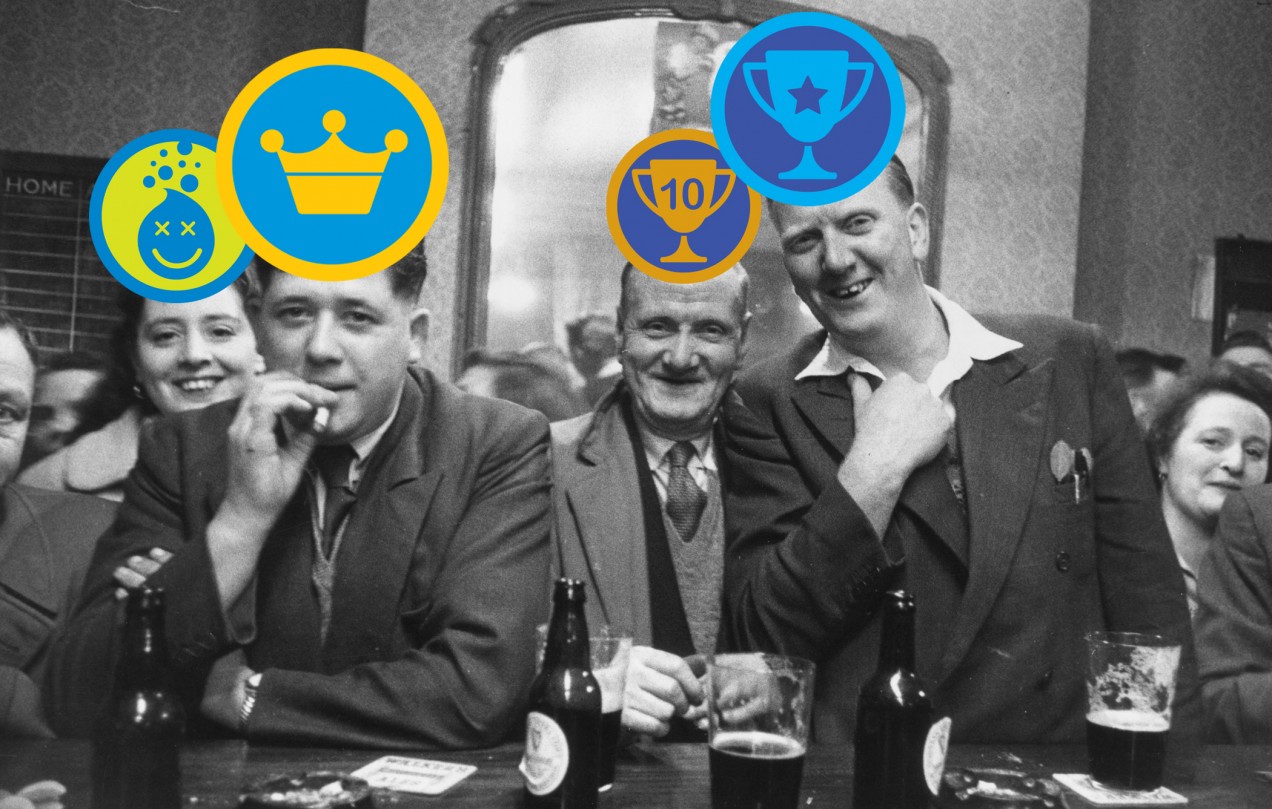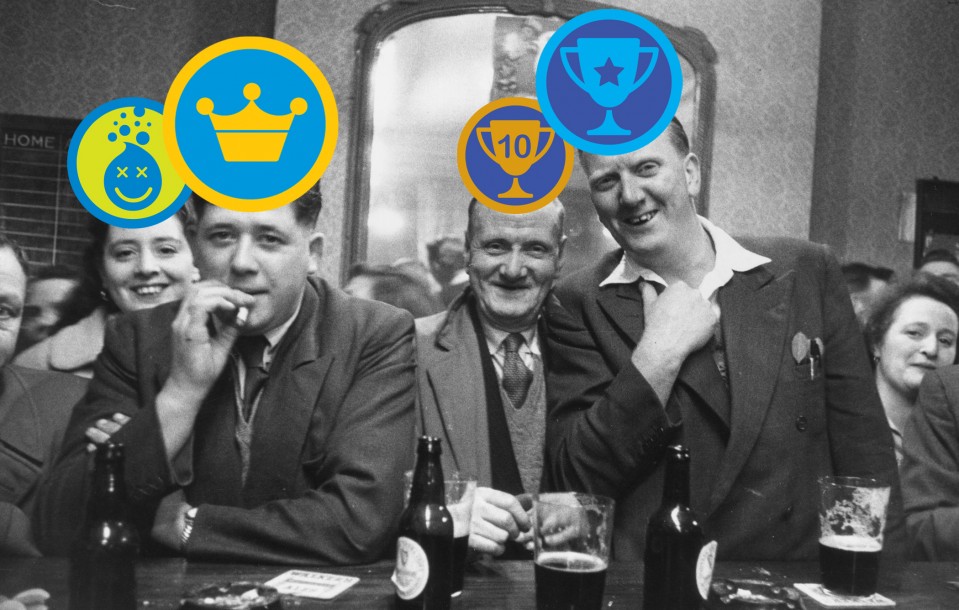

It's Good to Be the Mayor
Foursquare and other location-based social games on mobile phones can be compelling, but only when they harness the energy of countless offline games we’re already playing.

It’s an old retail trick: encourage people to buy things by turning consumption into a game. From the Green Stamps coupon program to frequent-flier miles, loyalty bonuses have been businesses’ way to reward customers in hopes of prodding them to buy even more. But now this technique is taking on a new and potentially more powerful form by exploiting the ubiquity of GPS-enabled smart phones and their users’ love of video games. More and more, businesses can use game elements—virtual points, levels, and challenges—to boost demand and shape consumer behavior.
One prominent startup behind this trend is Foursquare, which offers a smart-phone app that asks people to “check in” at bars, restaurants, and clubs. Foursquare awards points for check-ins and anoints the person who accumulates the most for one place during a certain period as the “mayor” of the location—a title that usually confers no benefits other than bragging rights. Foursquare has several competitors in the check-in game, including Gowalla, Brightkite, Whrrl, and Booyah. Another company, Scvngr, aims to take the concept further: its intense 22-year-old founder, Seth Priebatsch, likes to describe his goal as “building a game layer on top of the world.”
Game-ifying everything could become broadly popular, but only if the virtual prizes matter within our real-life social networks. Think of why Facebook works: it enhances and expands existing social connections. Something similar could happen with apps that offer games to play while you’re out and about. The real world is already overflowing with dynamics that amount to fascinating and complex social games, and apps will succeed by tapping into them rather than by trying to invent something entirely new.
Consider Foursquare. The game that drives its traffic was around long before the app. It is played in text messages and phone calls and can be traced back further, to guest books, gossip columns, and restaurant seating plans. This game might be called “What’s Going On Tonight?” The objects: meet the right people, avoid the wrong people, maximize fun. How to play: exchange information about your whereabouts (current and planned) with trusted friends. All Foursquare did was put this game on a smart phone and add one ingenious tweak—letting someone win the title of mayor.
It took Twitter two years to accrue its first million users; Foursquare did it in less than 14 months. Nine months later, it claims nearly six million registered users who check in 1.5 million times each day. This explosive growth attracted $20 million in a funding round led by Andreessen Horowitz. “A check-in is even more simple than sending a tweet,” says Naveen Selvadurai, Foursquare’s cofounder. “But it’s so loaded with data. You’re saying to businesses, ‘Hey, I’m here—do you want to send anything special to me?’ You’re telling your friends, ‘This would be a great place to meet up.’ You’re intimating a certain amount of intent.” Foursquare’s app shows some ads, but the company’s business model is still a work in progress. For now the company is focusing mainly on traffic growth.
Scvngr says it will hit the million-user mark even faster. It has also attracted about $20 million in funding, including significant backing from Google Ventures. Scvngr charges businesses monthly fees of $80 to $1,080 for premium listings that allow them to pose “challenges” to customers. In Scvngr’s standard example, customers at a burrito joint could be asked to fold their tinfoil wrapper into a piece of origami, take a picture of it, and upload it in exchange for Scvngr points, which can eventually be used to unlock rewards such as coupons. Beginning on “Black Friday,” the retail-obsessed day after Thanksgiving, Scvngr worked with Coca-Cola to create a series of location-based challenges at malls, like high-fiving other Coke drinkers. Top players could win gift cards.
I tested these services in Portland, Oregon, by strolling down NW 23rd Avenue, a trendy strip of boutiques. I tapped my phone to check in on Foursquare at establishment after establishment (checking in is on the honor system, and you can check in anywhere, but Foursquare will suggest places near where you happen to be). I also earned points on Scvngr for posting whatever photos and text struck my fancy. There didn’t seem to be much to it. At Powell’s City of Books, one of the world’s largest independent bookstores, Scvngr offered me a challenge called “our little secret.” “Climb the ranks from patron to regular,” the app urged, “by obtaining information about a special dish that is not listed on the menu.” The app was mistakenly categorizing Powell’s as a restaurant. I typed in “books.” Scvngr awarded me four points. I was supposed to feel proud. I felt nothing.
Foursquare’s app indicated that none of my Facebook friends who use the service were in the vicinity, so for a while I tried awkwardly approaching strangers like Carly Katherine L. at Little Big Burger, who graciously explained that her only Foursquare connections are three or four close friends. Asking her to add me would have been a hopeless overreach. But then again, Foursquare isn’t meant to be an icebreaker, because a Foursquare friend is far more intimate than many Facebook friends. You’re doing more than sharing your CV and vacation photos. You’re revealing your physical location. This isn’t something you want to share with those hundreds of acquaintances known to sociologists as “weak ties.” Foursquare friendship is necessarily limited to people with whom you might actually want to hang, right now. For users, that means a smaller potential pool of connections, yielding a slower stream of updates. But there would also seem to be longer-term value for businesses, because the stronger ties mean that tips passed from one user to another are likely to carry more weight. After all, the news that someone you like is at a particular restaurant, and excited enough to broadcast that news, is a powerful endorsement.
Foursquare guided me to Wieden + Kennedy, Portland’s marquee ad agency, which it identified as a “trending” location—meaning that it was seeing a cluster of check-ins. Standing in front of Wieden’s castle-like doors was an acquaintance, Aaron Rayburn, a 29-year-old designer and artist. Our meeting happened by old-fashioned coincidence—although Aaron is a serious Foursquare user, with 34 friends and four mayorships, including one at Portland’s Chinatown gate, he is selective about check-ins. Foursquare had no idea that he was visiting W+K. In fact, of the hundreds of employees who work in the firm’s Portland office, only six had checked in. Aaron whipped out his iPhone 4 and located the nearest happy hour. We were soon checking in at Vault, a cocktail lounge. One drink later, we were Foursquare friends, and he had started to explain the site’s appeal.
“When birds come back to the nest at night, they share information,” he said. “Where’s the food? How much is there?” He picked up his phone and acted out his part of the information-sharing. “ ‘Right now I’m out hunting and gathering at Vault. And it’s really great! You should come too.’ Foursquare scratches this itch that’s very ancient.”
Scvngr, on the other hand, tends to get users to do things for companies or organizations rather than for each other. Jewelers have used Scvngr to send couples on hunts for diamond rings. Museums, conferences, and college orientations have used Scvngr treks as icebreakers. There’s no equivalent to Aaron’s bird analogy—a compelling reason for someone outside one of these manufactured frameworks to play. Until Scvngr develops that, it will not resemble a game layer so much as a new form of marketing.
Jamin Brophy-Warren, cofounder of the gaming magazine Kill Screen, says this distinction is crucial. “Foursquare’s endgame is getting people out in the world and connecting with each other,” he says. “That’s different from a brand-first approach, where your goal is getting people to interact with a product. In the long term, it’s going to compromise the game.”
One proof of Foursquare’s deep appeal is that some people artificially boost their point totals by repeatedly checking in at venues without actually being there. Rob Z. of Portland, one of the accused, has racked up 6,169 check-ins, 56 badges, and 107 mayorships. “Please stop this guy,” one user pleaded on a Foursquare message board. “PDX is a great foursquare town and he is ruining it for us all.” Yes, the few yellow pixels that denote a badge are so desirable that someone is willing to cheat to get them, and someone else is willing to call him out on it.
It’s because the real object of desire—being known as the most regular of all regulars at your local—is a prize that was around well before you could tweet about it. Silly as it may seem, the glowing crown of a Foursquare mayorship shows the way forward for “real-world” games of tomorrow. The best ones won’t need to build a new layer on top of the world. They’ll find an especially rich old layer and mine it.
Matt Schwartz is a freelance writer whose work has appeared in Wired, Harper’s, Bloomberg Businessweek, and the New York Times Magazine.
Advertisement